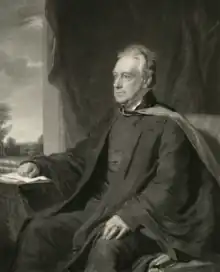William Bentinck (priest)
William Harry Edward Bentinck[lower-alpha 1] (2 February 1784 – 29 September 1868) was an Anglican clergyman, who served as Archdeacon of Westminster.

Bentinck was the oldest son of Lord Edward Bentinck (son of the 2nd Duke of Portland and younger brother of the 3rd Duke of Portland, the Prime Minister) and his wife Elizabeth Cumberland, daughter of the dramatist Richard Cumberland.[3]
He was educated at Westminster School[4] and Christ Church, Oxford, matriculating in 1802 aged 18, graduating B.A. 1805, M.A. 1808.[1] He was ordained deacon on 4 May 1807, and priest on 7 February 1808.[5]
Soon after his ordination, Bentinck was appointed Rector of Sigglesthorne, East Riding of Yorkshire, after King George III accepted the recommendation of the Prime Minister (Bentinck's uncle the Duke of Portland) on 27 February 1808.[6] He was appointed domestic chaplain to Edward Venables-Vernon, Archbishop of York in January 1810.[5] He was a canon of Westminster Abbey 1809–1864, becoming rural dean in 1842 and Archdeacon of Westminster.[lower-alpha 2] He resigned in October 1864.[10]
On 19 July 1814, Bentinck married Frances Constable, daughter of Thomas Constable (a priest).[3]
Bentinck paid for the construction of Holy Trinity Church, Bessborough Gardens, opened in 1852.[7][11] (After suffering damage in World War II, the church was demolished in 1954.)
Notes
- The second forename is given as Henry not Harry in some sources.[1] However, sources directly associated with Westminster Abbey give Harry.[2]
- Although reference works state that he became Archdeacon of Westminster in 1854,[4][7] Bentinck is already listed as Archdeacon of Westminster in sources from 1843[8] and 1846.[9]
References
- Foster, Joseph. . – via Wikisource.
- Brayley, Edward Wedlake (1818). The History and Antiquities of the Abbey Church of St. Peter. Vol. 1. Retrieved 19 May 2020.
- "Portland, Duke of (GB, 1716 - 1990)". Cracroft's Peerage. Retrieved 19 May 2020.
- Walford, Edward (1860). The County Families of the United Kingdom. p. 48. Retrieved 19 May 2020.
- https://theclergydatabase.org.uk/ ID 22530
- Aspinall, A., ed. (1962). The Later Correspondence of George III. Vol. 5. pp. 25–26. ISBN 9780521074513. Retrieved 19 May 2020.
- Boase, Frederic (2018) [1892]. Modern English Biography. Vol. 1. ISBN 9785041269647. Retrieved 19 May 2020.
- The Royal Kalendar and Court and City Register for England, Scotland, Ireland, and the Colonies for the Year 1843. 1843. p. 301. Retrieved 10 July 2021.
- Westminster Meeting. Proceedings of a meeting at the Hanover-Square Rooms on April 28, 1846, in behalf of the Society for the Propagation of the Gospel in Foreign Parts. 1846. p. 4. Retrieved 19 May 2020.
- "Church and Universities". The Illustrated London News. 29 October 1864. p. 431. Retrieved 19 May 2020.
- Beckett, John, ed. (2009). A History of The County of Middlesex: City of Westminster. The Victoria History of the Counties of England. Vol. 8. p. 183. ISBN 9781904356226. Retrieved 19 May 2020.